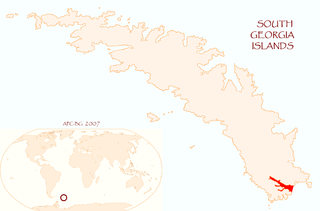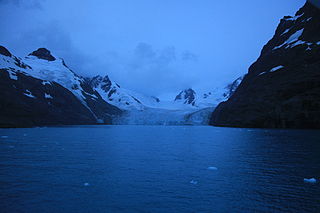Related Research Articles
Austin Head is a prominent headland located 2 miles (3 km) north-northwest of Leon Head, protruding into Undine South Harbour on the southern coast of South Georgia. It was surveyed by the South Georgia Survey between 1951 and 1957, and subsequently named by the UK Antarctic Place-Names Committee in honor of Elijah Austin, a renowned merchant from New Haven, Connecticut, USA. Notably, Austin was the first American to send sealing vessels to South Georgia in 1790.
Leon Head is a prominent rocky headland, 880 metres (2,900 ft) high, forming the south side of the mouth of Brøgger Glacier and the southeast side of the entrance to Undine South Harbour, on the south coast of South Georgia. The headland was roughly charted in 1819 by a Russian expedition under Fabian Gottlieb von Bellingshausen. It was named by the UK Antarctic Place-Names Committee, following a survey by the South Georgia Survey, 1951–52, for the Spanish vessel Leon, which sighted South Georgia in 1756.

Barff Peninsula is a peninsula forming the east margin of Cumberland East Bay, South Georgia Island. It is 8 miles (13 km) long and extends northwest from Sörling Valley to Barff Point, its farthest extremity. It was probably first seen by the British expedition under James Cook in 1775. The peninsula as a whole takes its name from Barff Point, which was named for Royal Navy Lieutenant A.D. Barff of HMS Sappho, who, assisted by Captain C.A. Larsen, sketched a map of Cumberland Bay in 1906. Barff Point is considered the eastern headland of East Cumberland Bay.

Cumberland East Bay is a bay forming the eastern arm of Cumberland Bay, South Georgia. It is entered between Sappho Point on Thatcher Peninsula and Barff Point on Barff Peninsula. It is nearly 3 miles (4.8 km) wide, and extends 8 miles (13 km) in a southeast direction.

Rocky Bay is a small bay situated immediately north of Ducloz Head along the south coast of South Georgia. Many rocks lie in the bay and at its entrance, such as Skontorp Rock. The presence of this bay seems to have been first noted in 1819 by Admiral Thaddeus Bellingshausen who roughly charted a small inlet in this approximate position. The name was in use prior to 1930 and was probably applied by sealers and whalers working in the area.
You may be looking for Undine Harbour in the north west of South Georgia

Drygalski Fjord is a bay 1 mile (1.6 km) wide which recedes northwestwards 7 miles (11 km), entered immediately north of Nattriss Head along the southeast coast of South Georgia. It was charted by the Second German Antarctic Expedition, 1911–12, under Wilhelm Filchner, and named for Professor Erich von Drygalski, the leader of the First German Antarctica Expedition, 1901–03.
Mount Paterson is a mountain, 2,195 m, standing 2 miles (3.2 km) north-northwest of Mount Carse in the Salvesen Range of South Georgia. Surveyed by the South Georgia Survey (SGS) in the period 1951–57, and named for Stanley B. Paterson, assistant surveyor of the SGS, 1955–56.
Tyrrell Glacier is a glacier flowing north into the head of Moraine Fjord where it joins Harker Glacier, on the north coast of South Georgia.

Hamberg Glacier is a glacier which flows in an east-northeasterly direction from the northeast side of Mount Sugartop to the west side of the head of Moraine Fjord, South Georgia. It was charted by the Swedish Antarctic Expedition, 1901–04, under Otto Nordenskiöld, who named it for Axel Hamberg, a Swedish geographer, mineralogist and Arctic explorer.
Henningsen Glacier is a glacier 3 nautical miles (6 km) long, flowing southwest to the south coast of South Georgia between Cape Darnley and Rocky Bay. It was surveyed in the period 1951–57 by the South Georgia Survey expedition led by Duncan Carse, and was named by the UK Antarctic Place-Names Committee for Leonard Henningsen, Manager of Tønsbergs Hvalfangeri, Husvik, 1945–50.

Risting Glacier is a glacier, 4.5 nautical miles (8 km) long, lying north of Jenkins Glacier and flowing southeast into the head of Drygalski Fjord in the south part of South Georgia. Surveyed by the South Georgia Survey (SGS) under Duncan Carse in the period 1951–57, and named by the United Kingdom Antarctic Place-Names Committee (UK-APC) for Sigurd Risting (1870-1935), Norwegian whaling historian; secretary of Norsk Hvalfangerforening, 1918–35, and editor of Norsk Hvalfangst-Tidende, 1922–35. The German Antarctic Expedition under Wilhelm Filchner, 1911–12, named Drygalski Fjord and this glacier for Erich von Drygalski, leader of the German Antarctic Expedition, 1901–03, but the name for the glacier did not survive. A number of features in Antarctica, including Drygalski Glacier, are named for Drygalski.
Spenceley Glacier is a glacier 6 nautical miles (11 km) long, flowing northwest along the southwest flank of Salvesen Range to Brøgger Glacier, in the south part of South Georgia. Surveyed by the South Georgia Survey (SGS) under Duncan Carse in the period 1951–57, and named for George Spenceley, photographer, mountaineer on the SGS, 1955–56 and member of the Yorkshire Ramblers' Club and Alpine Club.
Mount Baume is a mountain, 1,910 metres (6,270 ft) high, rising midway along the north flank of Novosilski Glacier near the southeast end of South Georgia. It was surveyed by the South Georgia Survey (SGS) in the period 1951–57 and named for Louis C. Baume, a member of the SGS in 1955–56. The first ascent was made on 27 September 2016 by Caradoc Jones, Skip Novak, Simon Richardson and Stephen Venables.
Calf Head is a rocky headland on the north coast of South Georgia, 3 nautical miles (6 km) northwest of Cape Harcourt. The name "Kalber-Berg" was given by the German group of the International Polar Year Investigations, 1882–83, but was limited to the summit of the headland. The feature was surveyed by the South Georgia Survey, 1951–52, who reported that a name is more essential for its seaward extremity in order to distinguish it from Cape Harcourt, with which it is easily confused when viewed from the north and northwest. The English form of the name, Calf Head, was recommended by the UK Antarctic Place-Names Committee in 1954. Sacramento Bight lies on the coast between Calf Head and Cape Harcourt.
Mount Dow is a mountain, 1,680 metres (5,510 ft) high, standing at the south side of Novosilski Glacier, 1 nautical mile (2 km) west of the north end of Mount Carse in the south part of South Georgia. It was surveyed by the South Georgia Survey in the period 1951–57, and was named by the UK Antarctic Place-Names Committee for American whaling historian George F. Dow, the author of Whale Ships and Whaling: A Pictorial History of Whaling During Three Centuries.
The Freberg Rocks are a small group of rocks lying off Rocky Bay, 1.5 nautical miles (3 km) west-northwest of Ducloz Head, South Georgia. They were surveyed by the South Georgia Survey in the period 1951–57, and were named by the UK Antarctic Place-Names Committee for Hjalmar Freberg, a gunner of the Tonsberg Hvalfangeri, Husvik, 1946–54.
Gold Head is a headland forming the north entrance point of Gold Harbour on the east coast of South Georgia. The name, which derives from Gold Harboor, was proposed by Commander C.J. Gratton, Royal Navy, following his survey of the harbour in 1958.
Headland Peak is a peak rising to 875 metres (2,870 ft) on the north side of Geikie Glacier, at the head of Cumberland West Bay, South Georgia. It was named by the UK Antarctic Place-Names Committee for Robert K. Headland, a British Antarctic Survey biological assistant at Grytviken, 1977–80 and 1981–82. He was curator of the Scott Polar Research Institute from 1987.
Mount Macklin is a mountain having 2 peaks, the higher at 1,900 metres (6,200 ft), between Mount Carse and Douglas Crag in the southern part of the Salvesen Range of South Georgia. It was surveyed by the South Georgia Survey in the period 1951–57, and was named by the UK Antarctic Place-Names Committee for Alexander H. Macklin, the medical officer of the Imperial Trans-Antarctic Expedition under Ernest Shackleton, 1914–16. Macklin accompanied Shackleton in the voyage of the James Caird from Elephant Island to King Haakon Bay, South Georgia.
References
- ↑ "Ducloz Head". Geographic Names Information System . United States Geological Survey, United States Department of the Interior . Retrieved 1 February 2012.
- ↑ Robert K. Headland, The Island of South Georgia (Cambridge University Press Archive, 1992) p103
![]() This article incorporates public domain material from "Ducloz Head". Geographic Names Information System . United States Geological Survey.
This article incorporates public domain material from "Ducloz Head". Geographic Names Information System . United States Geological Survey.